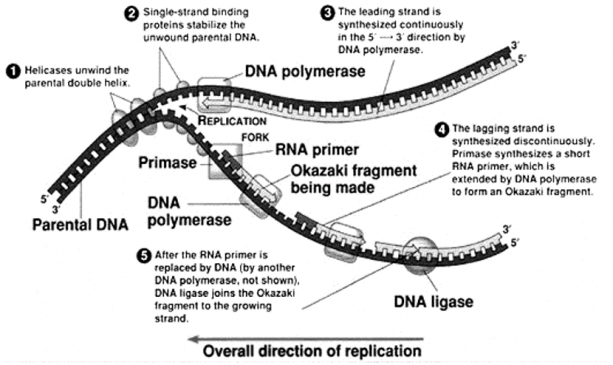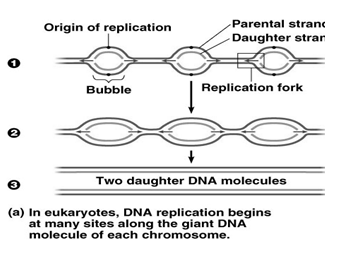Search Your Topic
DNA Replication- A Quick Revision (lecture-2)
DNA Replication
- Basis for inheritance
- The fundamental process occurring in all cells for copying DNA to transfer the genetic information to daughter cells
- Each cell must replicate its DNA before division.
Salient features of DNA replication
1) Semi conservative
- Parental strands are not degraded
- Base pairing allows each strand to serve as a template for a new strand
- New duplex is 1/2 parent template & 1/2 new DNA
2) Semi discontinuous- Leading & Lagging strands
- Leading strand – continuous synthesis
- Lagging strand – Okazaki fragments joined by ligases
3) The energy of Replication- The nucleotides arrive as nucleoside triphosphates with their own energy source for bonding
- DNA base, sugar with PPP
- P-P-P = energy for bonding
- Mono phosphate form is bonded by enzyme DNA polymerase III, a pyrophosphate is released, which is further broken down, the energy released is used for polymerization.
4) Primer is needed
- The DNA polymerase can only add nucleotides to 3′ end of a growing DNA strand needs a “starter” nucleotide to make a bond
- Primer serves as a starter sequence for DNA polymerase III
- RNA primer is synthesized by Primase
- RNA Primer has a free 3’OH group to which the first Nucleotide is bound.
- Only one RNA Primer-required for the leading strand
- RNA Primers for the lagging strand depend on the number of “OKAZAKI FRAGMENTS”
5) Template reading and direction of polymerization
- Each DNA strand serves as a template to guide the synthesis of the complementary strand.
- The template is read in the 3′-5′ direction while polymerization takes place in the 5′-3′ direction.
DNA Replication (Prokaryotes) Steps-
- Identification of the origins of replication
- Unwinding (denaturation) of dsDNA to provide a ssDNA template
- Formation of the replication fork
- Initiation of DNA synthesis and elongation
- Primer removal and ligation of the newly synthesized DNA segments
Components of Replication
DNA polymerases- Deoxynucleotide polymerization
Helicase -Processive unwinding of DNA
Topoisomerases relieve the torsional strain that results from helicase-induced unwinding
RNA primase initiates the synthesis of RNA primers
Single-strand binding proteins prevent premature reannealing of dsDNA
DNA ligase-seals the single strand nick between the nascent chain and Okazaki fragments on the lagging strand
1. Identification of Origin of Replication
- At the origin of replication (ori), there is an association of sequence-specific dsDNA-binding proteins with a series of direct repeat DNA sequences.
- In E coli, the oriC is bound by the protein dnaA
- a complex is formed consisting of 150–250 bp of DNA and multimers of the DNA-binding protein. This leads to the local denaturation and unwinding of an adjacent A+T-rich region of DNA.
Unwinding of double-stranded DNA to provide a single-stranded template
- The interaction of proteins with ori defines the start site of replication and provides a short region of ssDNA essential for initiation of synthesis of the nascent DNA strand.
- DNA Helicase allows for the processive unwinding of DNA.
- Single-stranded DNA-binding proteins (SSBs) stabilize this complex.
- Replication occurs in both directions along the length of DNA and both strands are replicated simultaneously.
- This replication process generates “replication bubbles”
- The further unwinding of DNA creates replication fork
Formation of Replication Fork– A replication fork consists of four components that form in the following sequence:
- DNA helicase unwinds a short segment of the parental duplex DNA
- A primase initiates the synthesis of an RNA molecule that is essential for priming DNA synthesis;
- DNA polymerase initiates nascent, daughter strand synthesis; and
- SSBs bind to ssDNA and prevent premature reannealing of ssDNA to dsDNA.

Figure-1 -showing the components and the processes involved at the replication fork.
The DNA Polymerase Complex
A number of different DNA polymerase molecules engage in DNA replication. These share three important properties:
(1) Chain elongation,
(2) Processivity, and
(3) Proofreading.
- Chain elongation accounts for the rate (in nucleotides per second) at which polymerization occurs.
- Processivity is an expression of the number of nucleotides added to the nascent chain before the polymerase disengages from the template.
- The proofreading function identifies copying errors and corrects them
- In E coli, polymerase III (pol III) functions at the replication fork. Of all polymerases, it catalyzes the highest rate of chain elongation and is the most processive.
- Polymerase II (pol II) is mostly involved in proofreading and DNA repair.
- Polymerase I (pol I) completes chain synthesis between Okazaki fragments on the lagging strand.
Differences between DNA Polymerase I, II and III
| Features | DNA pol I | DNA pol II | DNA pol III |
| Polymerization Rate | Low | Low | High |
| Processivity | Low | Low | High |
| Proofreading | 3’-5’ and
5’-3’ Exonuclease activities |
3’-5’ Exonuclease activity | 3’-5’ Exonuclease activity |
| Primer removal | Best | Nil | Nil |
| Strand synthesis | Lagging strand | No role | Both strands |
| DNA repair | Active | Active | No role |
DNA Topoisomerases
- Relief of supercoils is brought by Topoisomerases
Two types:
- Topoisomerases I: act by making a transient single cut in the backbone of the DNA, enabling the strands to swivel around each other to remove the build-up of twists
- Topoisomerases II (DNA gyrase) act by introducing double-stranded breaks enabling one double-stranded DNA to pass through another, thereby removing knots and entanglements that can form within and between DNA molecules.
Initiation of replication
- The polymerase III holoenzyme binds to template DNA as part of a multiprotein complex
- DNA polymerases only synthesize DNA in the 5′ to 3′ direction,
- Because the DNA strands are anti-parallel, the polymerase functions asymmetrically.
- On the leading (forward) strand, the DNA is synthesized continuously.
- On the lagging (retrograde) strand, the DNA is synthesized in short (1–5 kb)fragments, the so-called Okazaki fragments.
- Primer-The priming process involves the nucleophilic attack by the 3′-hydroxyl group of the RNA primer on the phosphate of the first entering deoxynucleoside triphosphate with the splitting off of pyrophosphate.
Elongation of DNA Synthesis
- Selection of the proper deoxyribonucleotide whose terminal 3′-hydroxyl group is to be attacked is dependent upon proper base pairing with the other strand of the DNA molecule according to the rules proposed originally by Watson and Crick.
- When an adenine deoxyribonucleoside monophosphoryl moiety is in the template position, a thymidine triphosphate will enter and its phosphate will be attacked by the 3′-hydroxyl group of the deoxyribonucleoside monophosphoryl most recently added to the polymer.
- By this stepwise process, the template dictates which deoxyribonucleoside triphosphate is complementary and by hydrogen bonding holds it in place while the 3′-hydroxyl group of the growing strand attacks and incorporates the new nucleotide into the polymer.
Primer removal and Nick sealing
- Primers are removed by DNA polymerase I by replacing ribonucleotides with deoxyribonucleotides
- Nicks are sealed by DNA ligase
- Multiple primers on the lagging strand while single primer on the leading strand.
Proofreading and Editing
DNA polymerase I
- Proofreads & corrects typos
- Repairs mismatched bases
- Removes abnormal bases
- Repairs damage
- Reduces error rate from 1 in 10,000 to 1 in 100 million bases
DNA Polymerase III
- Proofreads & corrects typos
- Repairs mismatched bases
- Removes abnormal bases
Termination of replication
- DNA replication terminates when replication forks reach specific “termination sites”.
- The two replication forks meet each other on the opposite end of the parental circular DNA.
- This process is completed in about 30 minutes, a replication rate of 3 x 105 bp/min in prokaryotes.
Replication in Eukaryotes
1) Origin of Replication -Eukaryotes
- Functionally similar autonomously replicating sequences (ARS) or replicators have been identified in yeast cells.
- The ARS contains a somewhat degenerate 11-bp sequence called the origin replication element (ORE).
- The ORE binds a set of proteins, analogous to the dnaA protein of E coli, which is collectively called the origin recognition complex (ORC).
- The ORE is located adjacent to an approximately 80-bp A+T-rich sequence that is easy to unwind. This is called the DNA unwinding element (DUE).
- Multiple origins of replications to duplicate the entire length of the genome (Figure-2)

Figure-2- Showing multiple origins of replication in eukaryotes
2) Eukaryotic DNA polymerases- There are 5 DNA Polymerases, each with a specific function
Comparison between Prokaryotic and Eukaryotic DNA polymerases
| E. coli | Mammalian | Function |
| I | Alpha | Gap filling and synthesis of the lagging strand |
| II | Epsilon | DNA proofreading and repair |
| βeta | DNA repair | |
| Gamma | Mitochondrial DNA synthesis | |
| III | delta | Processive, Leading strand synthesis |
3) Mammalian DNA polymerase Alpha is mainly responsible for the synthesis of primer.
4) Primer removal takes place by RNAse H
5) The entire mammalian genome replicates in approximately 9 hours.
6) Replication takes place during the “S” phase of cell cycle
7) Reconstitution of Chromatin Structure-chromatin structure must be re-formed after replication. Newly replicated DNA is rapidly assembled into nucleosomes, and the preexisting and newly assembled histone octamers are randomly distributed to each arm of the replication fork. Chromatin structure must be re-formed after replication.
8) The ends of chromosome (Telomeres) are replicated by Telomerase
Inhibitors of DNA replication-
- Bacterial DNA Gyrase (Type II Topoisomerase)- Inhibited by Novobiocin and Nalidixic acid.
- Ciprofloxacin interferes with DNA breakage and rejoining process.
- Mammalian topoisomerases – inhibited by Etoposide and Adriamycin, used as anticancer drugs.
- Nucleoside analogs 6- mercaptopurine, 5-FluoroUracil, and Cytosine Arabinoside also inhibit replication and are used as anticancer drugs.
